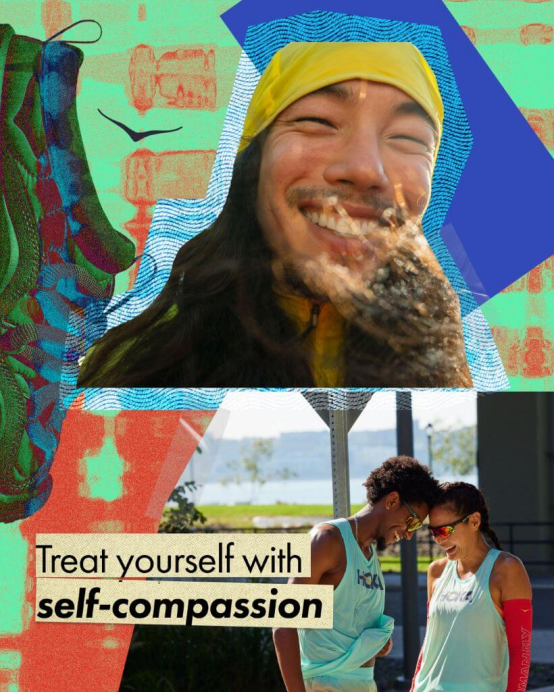Elevate Your Running Motivation with These Science-Backed Tips

Before Stephanie Harrison set out to run her first half marathon, she thought it was an unfathomable distance. As a self-proclaimed “casual runner,” the Los Angeles-based author initially had trouble imagining herself leveling up to the goal of racing 13.1.
But day-by-day, the science of happiness expert from Toronto increased her mileage, pushed herself further on long runs, and nailed the workouts in her training plan. After weeks of building strength and endurance, Stephanie accomplished her goal when she completed the Big Sur half marathon in 2013. More importantly, she had fun along the way.
“It made me feel proud of myself for taking on something that was previously so challenging and for showing up for it in those ways,” Stephanie says. “That in turn translated into me feeling more confident and empowered, which made setting new goals easier.”
Since 2018, Stephanie has shared her expertise in positive psychology through The New Happy, a newsletter, podcast, and blog with the mission of sharing a science-backed philosophy on happiness. In the spring, Stephanie published her first book, New Happy: Getting Happiness Right in a World That’s Got It Wrong, which soon became an international bestseller.
In a conversation with HOKA, Stephanie shared her experience with athletic goal-setting and discussed the science behind motivation, including how runners can use mental tools to accomplish their goals on the roads and beyond.
The core needs behind motivation
One helpful way to better understand motivation is through the self-determination theory. As Stephanie explains, the body of research argues humans have three core needs–autonomy, competence, and connection–which when fulfilled help us feel intrinsically motivated, or motivated from within, and not pressured by others.
“Intrinsic motivation is one of the most powerful forces in the world,” Stephanie says. “If you can find a way to tap into it, it will help you achieve everything that matters to you and you’ll feel really good as you do it.”
When determining your next running goal, you’ll want to consider those three core needs.

When it comes to autonomy–having the power to decide how to go about achieving the goal–ask yourself questions to pinpoint your training preferences. When is the best time to run? Where would you like to run? Do you want to join a group? Once you determine the factors that work best for your lifestyle, put them into action.
To satisfy the competence need, be honest about where you are in your life and don’t be afraid to push a little bit further. For example, if you’d like to run a half marathon but you’ve never run the distance before, your competence level is likely on the lower side. If that’s the case, start with a beginner training program that guides you through each step of the process and helps build confidence at every stage until you’re able to run 13.1.
To fulfill the need for connection, consider how you’d like to increase your connections to others as you chase the goal. “There’s a reason why run clubs are so popular because they offer you the experience of connection as you do something that’s relatively individual,” Stephanie says. “That connection to others can make it easier for you to show up. It can make it more fun and enjoyable.”
Set goals with intention
On top of meeting the three core needs, Stephanie suggests making goals that are rooted in joy. So many conversations about goal-setting include mentions of sacrifice or suffering, but Stephanie argues that you’re more likely to stick with a goal if it’s joyful. “Asking what would make this fun for me is a question we tend to ignore because of the conditioning around goal-setting but if you ask yourself that question, you might unlock some amazing things,” she says.
When Stephanie first started running when she lived in San Francisco, she thought about different ways she could make her runs more fun. Instead of logging miles indoors on a treadmill, she went to a trail next to the Golden Gate Bridge. “It turned into such a beautiful experience because I felt connected to nature,” she says.
Navigate challenges with compassion
Part of the process of chasing big goals includes navigating adversity along the way. In running, that could mean experiencing an injury or coping with a poor performance in a workout. While it’s common to be hard on ourselves in tough moments, research shows that approach often backfires. “Try to treat yourself with some self-compassion, which means you recognize that you’re a human being and things won’t always go as planned,” Stephanie says. “The challenges are simply part of the journey and oftentimes they’re necessary and teach us something.”

For example, if you get injured, you should take the time to rest and recover so you can come back stronger. The setback can also serve as a teaching moment to make adjustments for injury prevention in the future.
While it’s easy to get caught up in the outcome, it’s important to understand goal chasing involves many highs and lows and it’s crucial that we’re kind to ourselves at each point of the journey. “It’s about embracing every step of that process, knowing ultimately we want to support ourselves and be able to show up again for ourselves tomorrow,” Stephanie says.
Once you accomplish a goal, you progress in your level of competence as the achievement builds confidence for bigger aspirations down the line. Ultimately, motivation should be an ever-evolving process as setting new, tougher goals keeps things exciting.
“If you’re feeling a zap in motivation, don’t view that as a sign to give up, view it as a sign to switch things up, get creative, or elevate the challenge you’re taking on in some way,” Stephanie says. “That will help reinvigorate you.”
Follow Stephanie’s work @newhappyco and thenewhappy.com.

 USD
USD